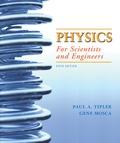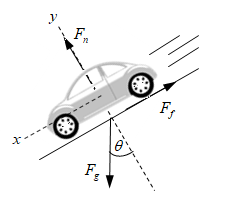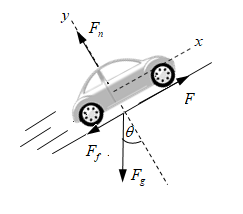
Concept explainers
(a)
The magnitude of the combined
(a)
Answer to Problem 99P
The magnitude of the combined force of friction at 20 m/s is 491 N and at 30 m/s is 981 N .
Explanation of Solution
Given:
On a 2.87° hill, speed of car is 20 m/s ,on a 5.74° hill, speed of car is 30 m/s and total mass of the car is 1000 kg .
Formula used:
Magnitude of force of friction at 20 m/s is F20 and magnitude of force of friction at 30 m/s is F30 .
The diagram representing the situation is given below.

Write the equation of resultant along the incline in equilibrium position.
∑Fx=0
Here, Fx is summation of all the forces along incline.
Substitute mgsinθ−Ff for Fx in above equation.
mgsinθ−Ff=0
Rearrange above equation.
Ff=mgsinθ …... (1)
Here, mgsinθ is component of Fg along the incline and Ff is the frictional force.
Calculation:
Whenspeed of car is 20 m/s .
Substitute 2.87° for θ , 1000 kg for m and 9.81 m/s2 for g in equation (1).
F20=(1000 kg)(9.81 m/s2 )sin(2.87°)≈491 N
Whenspeed of car is 30 m/s .
Substitute 5.74° for θ , 1000 kg for m and 9.81 m/s2 for g in equation (1).
F30=(1000 kg)(9.81 m/s2 )sin(5.74°)≈981 N
Conclusion:
Thus, the magnitude of the combined force of friction at 20 m/s is 491 N and at 30 m/s is 981 N .
(b)
The power delivered by the engine to drive the car on a level road at 20 m/s and at 30 m/s .
(b)
Answer to Problem 99P
The power delivered by the engine to drive the car on a level road at 20 m/s and at 30 m/s is 9.8 kW and 29 kW respectively.
Explanation of Solution
Given:
On a 2.87° hill, speed of car is 20 m/s , on a 5.74° hill, speed of car is 30 m/s , total mass of the car is 1000 kg the magnitude of the combined force of friction at 20 m/s is 491 N and at 30 m/s is 981 N .
Formula used:
Power delivered by the engine to drive the car on a level road at 20 m/s is P20 and power delivered by the engine to drive the car on a level road at 30 m/s is P30 .
Power delivered by the engine to drive the car on a level road in order to overcome friction is calculated by the expression given below.
Write the expression for power delivered.
P=Ffv ........(2)
Here, P is the power delivered and v is the speed of the car.
Calculation:
Substitute 491 N for Ff and 20 m/s for v in equation (2).
P20=(491 N)(20 m/s)=9820 W=9.8 kW
Substitute 981 N for Ff and 30 m/s for v in equation (2).
P30=(981 N)(30 m/s)=29430 W=29 kW
Conclusion:
Thus, the power delivered by the engine to drive the car on a level road at 20 m/s and at 30 m/s is 9.8 kW and 29 kW respectively.
(c)
The angle of the steepest incline up which can be maintained by car at steady speed of 20 m/s .
(c)
Answer to Problem 99P
The angle of the steepest incline up which can be maintained by car at steady speed of 20 m/s is 8.8° .
Explanation of Solution
Given:
On a 2.87° hill, speed of car is 20 m/s , on a 5.74° hill, speed of car is 30 m/s , total mass of the car is 1000 kg the magnitude of the combined force of friction at 20 m/s is 491 N and at 30 m/s is 981 N .
Formula used:
The diagram representing the situation is given below.

Write the equation of resultant along the incline in equilibrium position.
∑Fx=0
Here, Fx is summation of all the forces along incline.
Substitute F−mgsinθ−Ff for Fx in above equation.
F−mgsinθ−Ff=0
Rearrange above equation.
F=mgsinθ+Ff
Here, F is the external force.
Substitute Pv for F in above equation.
Pv=mgsinθ+Ff
Rearrange above equation for θ .
θ=sin−1[Pv−Ffmg] …... (3)
Calculation:
Substitute 20 m/s for v , 40 kW for P , 1000 kg for m , 491 N for Ff and 9.81 m/s2 for g in equation (3).
θ=sin−1[40 kW20 m/s−491 N(1000 kg)(9.81 m/s2 )]=sin−1[15099810]=8.8°
Conclusion:
Thus, the angle of the steepest incline up which can be maintained by car at steady speed of 20 m/s is 8.8° .
(d)
The total useful work in kilometers per liter when engine goes at 30 m/s .
(d)
Answer to Problem 99P
The total useful work in kilometers per liter when engine goes at 30 m/s is 6.36 km/L .
Explanation of Solution
Given:
The magnitude of the combined force of friction at 20 m/s is 491 N and at 30 m/s is 981 N .
Formula used:
Write the expression for work done by engine.
W=FΔs
Here, W is the work done, F is the force and Δs is the distance in kilometers per liter.
From the condition of equivalence:
F20Δs20=F30Δs30
Here, Δs20 is the distance in kilometers per liter when speed is 20 m/s and Δs30 is the distance in kilometers per liter when speed is 30 m/s .
Rearrange above equation.
Δs30=F20F30Δs20 ........(4)
Calculation:
Substitute 491 N for F20 , 981 N for F30 and 12.7 km/L for s20 in equation (4).
Δs30=491 N981 N(12.7 km/L)=6.36 km/L
Conclusion:
Thus, the total useful work in kilometers per liter when engine goes at 30 m/s is 6.36 km/L .
Want to see more full solutions like this?
Chapter 7 Solutions
Physics for Scientists and Engineers
- A man slides two boxes up a slope. The two boxes A and B have a mass of 75 kg and 50 kg, respectively. (a) Draw the free body diagram (FBD) of the two crates. (b) Determine the tension in the cable that the man must exert to cause imminent movement from rest of the two boxes. Static friction coefficient USA = 0.25 HSB = 0.35 Kinetic friction coefficient HkA = 0.20 HkB = 0.25 M₁ = 75 kg MB = 50 kg P 35° Figure 3 B 200arrow_forwardA golf ball is struck with a velocity of 20 m/s at point A as shown below (Figure 4). (a) Determine the distance "d" and the time of flight from A to B; (b) Determine the magnitude and the direction of the speed at which the ball strikes the ground at B. 10° V₁ = 20m/s 35º Figure 4 d Barrow_forwardThe rectangular loop of wire shown in the figure (Figure 1) has a mass of 0.18 g per centimeter of length and is pivoted about side ab on a frictionless axis. The current in the wire is 8.5 A in the direction shown. Find the magnitude of the magnetic field parallel to the y-axis that will cause the loop to swing up until its plane makes an angle of 30.0 ∘ with the yz-plane. Find the direction of the magnetic field parallel to the y-axis that will cause the loop to swing up until its plane makes an angle of 30.0 ∘ with the yz-plane.arrow_forward
- A particle with a charge of − 5.20 nC is moving in a uniform magnetic field of (B→=−( 1.22 T )k^. The magnetic force on the particle is measured to be (F→=−( 3.50×10−7 N )i^+( 7.60×10−7 N )j^. Calculate the y and z component of the velocity of the particle.arrow_forwardneed answer asap please thank youarrow_forward3. a. Determine the potential difference between points A and B. b. Why does point A have a higher potential energy? Q = +1.0 C 3.2 cm 4.8 cm Aarrow_forward
 Classical Dynamics of Particles and SystemsPhysicsISBN:9780534408961Author:Stephen T. Thornton, Jerry B. MarionPublisher:Cengage Learning
Classical Dynamics of Particles and SystemsPhysicsISBN:9780534408961Author:Stephen T. Thornton, Jerry B. MarionPublisher:Cengage Learning Glencoe Physics: Principles and Problems, Student...PhysicsISBN:9780078807213Author:Paul W. ZitzewitzPublisher:Glencoe/McGraw-Hill
Glencoe Physics: Principles and Problems, Student...PhysicsISBN:9780078807213Author:Paul W. ZitzewitzPublisher:Glencoe/McGraw-Hill Principles of Physics: A Calculus-Based TextPhysicsISBN:9781133104261Author:Raymond A. Serway, John W. JewettPublisher:Cengage Learning
Principles of Physics: A Calculus-Based TextPhysicsISBN:9781133104261Author:Raymond A. Serway, John W. JewettPublisher:Cengage Learning University Physics Volume 1PhysicsISBN:9781938168277Author:William Moebs, Samuel J. Ling, Jeff SannyPublisher:OpenStax - Rice University
University Physics Volume 1PhysicsISBN:9781938168277Author:William Moebs, Samuel J. Ling, Jeff SannyPublisher:OpenStax - Rice University Physics for Scientists and Engineers, Technology ...PhysicsISBN:9781305116399Author:Raymond A. Serway, John W. JewettPublisher:Cengage Learning
Physics for Scientists and Engineers, Technology ...PhysicsISBN:9781305116399Author:Raymond A. Serway, John W. JewettPublisher:Cengage Learning An Introduction to Physical SciencePhysicsISBN:9781305079137Author:James Shipman, Jerry D. Wilson, Charles A. Higgins, Omar TorresPublisher:Cengage Learning
An Introduction to Physical SciencePhysicsISBN:9781305079137Author:James Shipman, Jerry D. Wilson, Charles A. Higgins, Omar TorresPublisher:Cengage Learning





